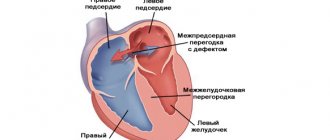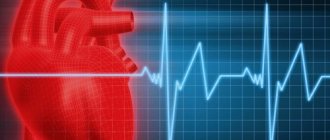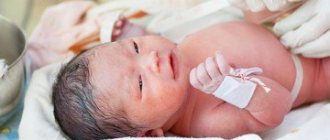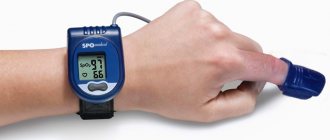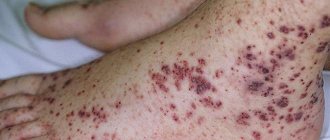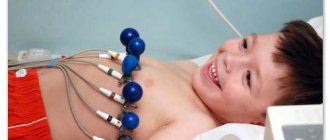A protrusion of the septum separating the right and left atrium (where it is thinnest) by more than one centimeter is called an aneurysm, but in cardiological practice, smaller deformations are often also classified as a disease, especially if this causes negative manifestations. Curvature of the sac is not life-threatening, so it is classified as a minor cardiac anomaly. In most cases, patients are monitored dynamically, but some have to undergo surgical treatment.
Aneurysm of the interatrial septum
Features of the disease
The main diagnostic criterion for atrial septal aneurysm is the size of the protrusion exceeding 10 mm. The diagnosis can be established when the size of the formation is less than 10 mm based on the detected hemodynamic disturbance (blood flow), as well as a combination with other heart defects (prolapse or sagging valves). The prognosis of the disease is favorable.
Schematic illustration
For small-sized protrusions, special therapeutic measures are not carried out, since there are no hemodynamic disturbances. As long as preventive recommendations are followed to prevent the development of cardiovascular pathology, there are no restrictions on life expectancy in patients with pathology.
Spontaneous (spontaneous) rupture of protrusion is recorded in 10% of cases in adults, usually after myocarditis or other heart diseases that provoke a decrease in the strength of the septal tissues.
Congenital heart disease (CHD) in the form of atrial aneurysm is rare (less than 1% of cases in newborns). It is registered equally often in boys and girls. A separate category is acquired pathology, which is diagnosed in adults after suffering heart pathology (myocardial infarction, myocarditis, cardiomyopathy).
Causes
Development factors have not been sufficiently studied. Based on the known data, the following conclusions can be drawn.
Congenital forms
They are represented mainly by genetic syndromes; spontaneous mutations occur less frequently as a result of the impact of negative factors on the body of the expectant mother (chemical reagents, ionizing radiation, drugs).
- Down syndrome. Trisomy. Contrary to the possible beliefs of the average person, it is determined not only by severe mental retardation. Also cardiac problems, which are the cause of early death among patients in this group. Interatrial aneurysm is considered a relatively common type of process, but far from the only one. At the same moment, there are several types of anatomical defects. All of them together cause increased mortality. Many patients do not live to see 10 years of age.
- Pallister-Killian syndrome. Characterized by massive deviations from the cardiovascular system. Aneurysm of the interatrial septum is a clinically common variant that is part of a typical complex.
- Cardiofacial syndrome. A relatively rare pathology. Characterized by heart lesions, as well as cosmetic defects (recovery is carried out under the supervision of an oral surgeon).
- Sickel syndrome.
Other pathological processes. There are dozens of possible developmental disorders. All, one way or another, affect the condition of the atrial septum.
Acquired forms
Are determined more often. The ratio, according to a few studies, is 70% versus 30% (phenotypic and genetic pathologies, respectively).
We can name the following conditions preceding the defect in question:
- Inflammatory lesions of the heart and surrounding structures. Usually has an infectious nature, somewhat less often autoimmune. The classic form is myocarditis. The deviation is accompanied by a prolonged increase in body temperature, chest pain, rhythm problems, shortness of breath, changes in objective blood indicators and instrumental techniques. Treatment should begin from the very first days of the pathological process. Delay can have catastrophic consequences. STD aneurysm is a clinical variant of an acquired defect that develops at an early stage. Without medical care, complete destruction of cardiac structures occurs.
- Heart attack. Acute death of the heart muscle. Depending on the location of the process, a decrease in blood circulation of varying severity occurs. As the deviation develops, the elasticity of the septum decreases. There is a protrusion towards one or two atria at once. Such consequences are relatively rare and are detected only by objective means as part of the early diagnosis of cardiosclerosis and failure after an emergency.
- Ischemic disease. Chronic circulatory disorders in cardiac structures. Its character resembles a heart attack, but the decrease in hemodynamics does not reach a certain critical level. Without timely treatment, myocardial necrosis will occur, but somewhat later. When depends on the degree of ischemia. Such patients should be examined every 3-6 months. Lifelong treatment. The probability of an atrial septal aneurysm is about 30%, possibly higher; there is not enough empirical material for far-reaching generalizations.
- Rheumatism. Autoimmune pathological process. It develops at any age and what causes it is not known for certain. It is assumed that viral agents play a major role, passing into cardiac structures from distant sources, but not provoking inflammation as such. Treatment is lifelong, with the use of immunosuppressants during the acute period. Aneurysm of the septum of the heart is a late acquired defect that is eliminated by surgical methods, if indicated.
- Hypertensive process of any origin. Increased blood pressure. Creates a significant load on all cardiac structures. Malformations of cardiac formations, including septum, are possible. Stable hypertension with high tonometer readings is especially dangerous.
- Acquired cardiac malformations of a different origin. May cause an aneurysm. It is impossible to say for sure in what percentage of cases this occurs. However, there is a pattern. When mitral valve prolapse or stenosis is detected, the pathology in question is diagnosed in almost 20% of cases. Which suggests a possible connection.
- Aortic insufficiency.
- Atherosclerosis of large arteries. It occurs against the background of other conditions, that is, it turns out to be secondary. Accompanied by a generalized disturbance of circulatory processes in the body. Cardiac structures also suffer. The consequence is heart defects. It takes more than one year to develop, so there is enough time for prevention or high-quality detection.
- Pulmonary hypertension. An increase in pressure in the corresponding artery. Characterized by an increase in the mass of the muscular organ (the so-called cor pulmonale). Against the background of the current process, additional deviations in the development of cardiac structures are possible.
The exact reasons, however, are not known. In some cases, the process occurs spontaneously, and diagnostics do not yield results. Then they talk about the idiopathic variety.
How is it formed?
Depending on the origin, congenital and acquired aneurysm of the septum between the atria is distinguished. A congenital anomaly is formed in childhood, and an acquired one develops as a result of exposure to provoking factors in an adult.
Congenital
The formation of an aneurysm in the fetus has certain characteristics. It can be combined with a violation of the fusion of the oval window (communication in the interatrial septum), which ensures the discharge of blood from the right circulation to the left. This is due to the fact that the lungs do not yet perform their function.
After the first inhalation, the right circle of blood circulation is turned on. During the first few days or weeks after birth, the diameter of the oval window decreases, fusion occurs (the duration of the period of fusion of the oval window is individual for each person), in the place of which a small depression remains. When exposed to various reasons, the healing process is disrupted, as a result of which the connective tissue has less strength, where a protrusion forms over time.
The exact cause of the development of an aneurysm remains unclear today.
There are several provoking factors, which include:
- hereditary predisposition;
- bad habits of parents;
- past infectious diseases during pregnancy (toxoplasmosis), exposure to adverse environmental factors (ionizing radiation, toxins).
Congenital aneurysm may have an isolated origin. In this case, the localization of the fossa ovale and the protrusion in the septum often do not coincide. The mechanism of development is usually associated with a primary hemodynamic disorder in the heart, which results in the formation of a protrusion in the area of high blood pressure.
Acquired
The mechanism of development of acquired septal aneurysm involves weakening of the septal tissue with subsequent formation of a bulge. It is a consequence of the influence of provoking factors (previous myocardial infarction, myocarditis, cardiomyopathy).
Development mechanism in the form of a table:
| Origin | Pathogenesis |
| Isolated congenital anomaly | Protrusion is formed due to hemodynamic disturbances in childhood |
| Anomaly combined with malformations of the oval window | Violation of the fusion of the oval window provokes the formation of a protrusion |
| Acquired aneurysm | Develops in adults due to weakening of the septal tissue, which provokes myocardial infarction, myocarditis, cardiomyopathy |
Since acquired aneurysm of the septum between the atria in most cases is the result of a myocardial infarction, it is divided into several types:
- Acute aneurysm - formation forms within 14 days after a heart attack. It is accompanied by a deterioration in the person’s condition with fever, arrhythmia (disturbance in the rhythm of contractions), and an increase in the number of leukocytes per unit volume of blood.
- Subacute aneurysm - the anomaly develops over 3-6 weeks, the protrusion is a consequence of a disruption in the formation of a connective tissue scar in the area of dead myocardiocytes. It is characterized by the gradual development of heart failure with shortness of breath, increased fatigue, swelling of soft tissues with a predominant localization on the legs.
- Chronic aneurysm - the formation of a protrusion in the septum between the atria occurs over a period of time exceeding 6 weeks and is accompanied by a gradual increase in the symptoms of congestive heart failure.
Division into types makes it possible to predict the further course of the pathology, as well as select the most adequate therapy.
Mechanisms of formation
The disease is quite rare - no more than one percent among the general population. People of both sexes suffer equally, most often children (80% of the total number of cases) and the elderly.
According to the shape of the curvature, there are several options: left (L), right (R) and S-shaped (RL - first to the right and then to the left and LR - vice versa.). The latter is more dangerous.
There may or may not be a hole in the interatrial septum (through which blood is ejected into the right atrium). There are two types of pathologies based on their origin; they will be described below (you can see more details about this in the video posted in this article).
Congenital pathology
Aneurysm of the interatrial septum in adults
The disease is diagnosed in young children, usually during a preventive medical examination.
The formation of an intrauterine aneurysm occurs in the womb and is caused by:
- hereditary predisposition;
- pathologies of embryogenesis or infectious invasions;
- the presence of harmful habits in the mother or strong emotional upheavals during pregnancy.
Pathogenesis happens:
- Systemic. In this case, deformation transformations of the connective tissue are formed in various organs: kidneys, central nervous system, eyes, blood vessels, and so on.
- Local (isolated) - the lesion concerns exclusively the interatrial septum, which is recorded much less frequently than in the first case.
During fetal development, the MPP has an oval window, designed to transfer blood from the left atrium to the adjacent one. This is necessary so that it does not enter the pulmonary circle while there is no breathing.
After the child’s lungs begin to breathe, the oval window closes and hemocirculation no longer occurs through it. Otherwise, when normal fusion does not occur, the septum is closed by connective tissue that can sag in any direction, or a hole remains in it.
In the first case, an aneurysm forms. Sometimes the pathology develops in older children, which is associated with a slow or delayed tightening of the oval window.
Most often, an aneurysm of the sac is congenital and is diagnosed in the first years of life.
Acquired form
This pathology is more often observed in adults who are 50 years of age or older. Its formation may be associated with a heart attack or a consequence of senile anatomical deformations in the body.
What happens?
The interatrial septum normally should not have a curvature exceeding 5 mm.
Accordingly, if the aneurysm is larger than this size, then its appearance can lead to the following disorders:
- Compression of the valve apparatus - when the protrusion is localized in the lower parts of the interatrial wall, the tricuspid or mitral valve may be compressed.
- Insufficient blood outflow with incomplete emptying of the atrium, increased pressure in it, leading to changes in hemodynamics in the left or right ventricle.
- An increase in blood pressure in the right circulation with a deterioration in blood oxygen saturation and the development of hypoxia. It usually develops as a result of an aneurysm combined with incomplete fusion of the oval window.
- The formation of blood clots, provoked by a change in blood flow in the area of the aneurysm - blood clots can break off, enter the general bloodstream, clog arterial vessels with the development of severe complications, which include myocardial infarction and cerebral stroke.
According to the pathogenesis of the consequences, an aneurysm is distinguished with a discharge of blood (usually in combination with a patent oval window) and without it (hemodynamics in the heart have a slight change).
Effective therapies
Having decided what an aneurysm is, it is necessary to pay attention to how to treat such pathological formations with traditional means, as well as preventive measures in order to reduce the danger and risks of developing unpleasant symptoms of the anomaly.
In the early stages of the disease, as well as with a standard clinical picture of the disease, as a rule, an interatrial aneurysm does not pose any particular danger, and patients in this case do not require either medication or surgical treatment. However, in situations where a person is tormented by unpleasant general symptoms and frequent ailments, therapeutic procedures involve the use of the following types of medications:
- Vitamins and all necessary microelements, which, in particular, are indispensable for the normal functioning of the heart muscle. They are potassium and magnesium, as well as B vitamins, which can enrich the blood with oxygen.
- Medications that affect the regulation of heart rhythm during attacks of tachycardia and cardiac arrhythmias with aneurysm of the interatrial septum ICD I25.3.
- Sedative and sedative medications.
- Blood thinning medications that are recommended to be taken if pulmonary hypertension develops.
Forms
Depending on the direction of the protrusion, several forms of anomaly are distinguished:
- L-type – deflection is directed to the left (towards the left atrium).
- R-type – protrusion is directed to the right.
- S-type - the protrusion has an S-shape, it is simultaneously partially directed into the left and right atrium.
Depending on the direction of the protrusion, the doctor can predict the possible development of changes in the mitral or tricuspid valve.
A separate form of aneurysm is distinguished, combined with other anomalies (valvular defects, defect of the oval window). With it, hemodynamic disturbances are more pronounced, the risk of complications increases, and the manifestations of heart failure intensify.
Conservative methods of treatment of sac aneurysm in children
A small aneurysm in a child, which does not affect the quality of his life and level of development, can remain throughout the child’s life. This is especially true for those children in whom surgical removal of an aneurysm is contraindicated. At the same time, it is important to adhere to preventive measures and constantly see a doctor.
For those who are contraindicated for surgical intervention, doctors recommend following the regime, properly planning a combination of rest and exercise. You should not prohibit your baby from actively moving. Since light physical activity, such as daily walks, cycling has a positive effect on the cardiovascular system. But you shouldn’t overdo it either.
Nutrition also needs to be balanced. It is recommended that infants be fed breast milk during the first year of life. This reduces the risk of developing infectious diseases, which often provoke complications associated with the functionality of the heart. The transition to a normal diet should contain a sufficient amount of essential minerals and vitamins.
Don't forget about strengthening therapy. It is recommended to do gymnastics, massage, and baths with medicinal herbs every day.
Parents of children diagnosed with an aneurysm of the bladder should monitor them, prevent the development of stressful situations in children, and constantly visit a pediatrician and neurologist.
How can you suspect?
With small aneurysms, often no symptoms are observed. As the formation increases with changes in hemodynamics in the heart, the following clinical manifestations may appear, which will help to suspect the presence of pathology:
- Tachycardia is an increase in heart contractions, which is more often recorded when it protrudes into the right atrium.
- Signs of blood stagnation in the small circle, which develop regardless of age and are the result of a combination with incomplete fusion of the oval window. These include shortness of breath, arrhythmias, cyanosis (bluish discoloration) of the skin, frequent development of inflammation of the bronchi and lungs.
- Signs of hemodynamic disturbances, which often develop in adolescence and are provoked by body growth, changes in the functional state of the endocrine system - increased fatigue, the appearance of a feeling of discomfort in the chest, arrhythmia, frequent dizziness.
- Symptoms of heart failure in adults are shortness of breath, swelling of peripheral tissues (mainly developing in the legs in the late afternoon), periodic wet cough, which has a paroxysmal nature. Signs usually appear against the background of the development of subacute or chronic aneurysm after myocardial infarction.
The appearance of signs of changes in the functioning of the heart and blood vessels requires consultation with a doctor.
What is the life expectancy of patients with atrial aneurysm?
According to statistics, the average life expectancy for people with atrial aneurysm is 40-45 years.
It is possible that patients live up to 80 years of age. But even with this, the diagnosis of “suppressive aneurysm” makes a person disabled at 50 years of age. This happens due to increased pressure in the lungs.
However, there are also positive exceptions: in 3-5% of children, involuntary restoration of the atrial septal defect is observed.
Patients suffering from atrial aneurysm are in most cases diagnosed with chronic pneumonia, which develops due to frequent diseases of the respiratory system. Some infants with an aneurysm die in infancy. The fatal outcome in this case is about 10%. The addition of secondary pneumonia and rheumatism in children is also often observed.
Diagnostics
Since clinical manifestations of an aneurysm may be absent or nonspecific, the main role in identifying pathology belongs to objective diagnostic methods:
- EchoCG (echocardiography) or ultrasound of the heart is a reference research technique that allows you to visualize the septum and changes in it. An option is transesophageal echocardiography (TE EchoCG), which makes it possible to visualize minimal changes. Echocardiography is necessarily prescribed to newborn children when a doctor listens to a heart murmur.
- Dopplerography is an ultrasound examination that detects hemodynamic disorders.
- ECG (electrocardiography) is a functional study of the heart.
- Computed tomography is an x-ray technique for visualizing the structures of the heart and has high resolution.
Also, if necessary, the doctor prescribes other methods of laboratory, instrumental and functional research.
How is diagnostics carried out?
Detection of atrial septal aneurysm is carried out in a medical institution. The patient undergoes a primary medical examination, during which other possible diseases are excluded. A comprehensive examination is carried out:
- Ultrasound of the heart is the most common way to identify pathology and determine its shape;
- ECG is a simple method in which it is possible to detect heart rhythm disturbances and exclude arrhythmia;
- X-ray – the image shows a specific symptom – the roots of the lungs are pulsating;
- CT scan;
- Catheterization of cardiac chambers.
Additionally, a laboratory blood test is performed to check for inflammatory processes. It is important that the prognosis and treatment be carried out by an experienced cardiologist, since the disease is dangerous and carries many risks.
How to treat?
When a defect forms without bleeding, as well as when the size of the protrusion is less than 10 mm, special therapeutic measures are not prescribed. The patient is observed by a cardiologist (dispensary registration) with the implementation of general and dietary recommendations.
In case of more serious protrusion, complex treatment is prescribed, which includes drug therapy and surgery.
Drug treatment
Medicines from several pharmacological groups can be used for treatment:
- Medicines for increasing blood pressure (caffeine-sodium benzoate).
- Potassium and magnesium preparations that improve the contractile function of the heart (Panangin).
- Vitamin preparations with a high content of B vitamins (Neurovitan).
- Antiarrhythmic drugs (Panangin).
- Cardiac glycosides (Digoxin).
The choice of drugs and their dosage is made only by the attending physician.
Surgical treatment
The main medical indications for performing the operation are pronounced changes in hemodynamics (blood discharge), as well as the presence of other concomitant heart defects.
The course of the operation includes several stages:
- Providing access.
- Excision of altered tissues.
- Plastic with hole closure.
Before prescribing surgical intervention, the doctor excludes the presence of absolute (severe decompensated heart failure) and relative (age of the child, presence of acute infectious diseases, exacerbation of chronic somatic pathology) contraindications.
Lifestyle change
Maintaining a correct lifestyle is the main direction of successful prevention of cardiovascular disorders, and it can also be used as an addition to treatment.
Required:
- Sufficient physical activity to strengthen the heart and blood vessels without excessive stress.
- Rationalization of the work and rest regime - it is recommended to take a break every 40 minutes of mental work. Sleep should be at least 8 hours a day.
- Refusal of bad habits in adults (smoking, systematic alcohol consumption affects blood vessels and hemodynamics, provokes an increase in protrusion).
- Limiting the effects of stress and excessive mental stress.
- Timely detection and treatment of chronic pathologies.
IMPORTANT! Dosed physical activity for half an hour a day can reduce the risk of developing cardiovascular pathology by as much as 30%.
Diet
Following dietary recommendations makes it possible to avoid other diseases (diabetes mellitus, hypertension) that can cause complications, as well as strengthen the tissue of the interatrial septum.
These include:
- Limit fatty, fried foods, sweets.
- Refusal of alcoholic drinks.
- Increasing the volume of plant foods (vegetables, fruits) and lean meats (chicken, rabbit) in the diet.
- Frequently eat food (at least 5 times a day) in small portions.
- Dinner 4 hours before bedtime.
Prevention of aneurysm of the bladder
When you have found out what an atrial septal aneurysm is, how difficult diagnosis and treatment will be, it is worth thinking about preventive measures. They will reduce the risk of developing pathology, and will also alleviate the course of the disease if an aneurysm has already formed. The following measures must be observed:
- Take infectious diseases seriously - any cold or flu must be treated urgently, as they can accelerate the growth of the tumor. It is your right to see a doctor or not, but it is better to carry out such treatment under the supervision of a specialist;
- Treat your cough immediately - even such a harmless disease can lead to rupture of the walls; it would be better to do an examination during this period;
- Completely give up bad habits, which will have a positive effect not only on the functioning of the heart, but also on the whole body;
- Eat a nutritious and balanced diet. You will have to remove harmful fatty foods from your diet, as they contribute to the formation of blood clots and plaques in the vessels, and since the blood flow is already impaired, additional deviation is unacceptable;
- Monitor the development of atherosclerosis, blood pressure and weight. If necessary, use medications as prescribed by your doctor.
In addition, moderate physical activity, lack of stress and a precise daily routine with sufficient time for sleep and rest will help reduce the risk of illness or complications.
STD aneurysm is a pathology that can form in a person of any age, occurring without symptoms. But the absence of signs does not mean that the disease is not dangerous; there is always a risk of rupture or complications. So the patient should undergo regular examinations to identify an aneurysm and other defects in the heart or circulatory system.
Prevention and prognosis
Primary prevention is carried out in healthy people to prevent the development of an acquired anomaly. It includes changes in lifestyle (sufficient physical activity, rational work and rest, giving up bad habits), as well as following dietary recommendations (refusing fatty, fried foods, eating vegetables, fruits, dietary meat).
If a child is diagnosed with a protrusion, he must be registered with a cardiologist, who monitors the dynamics of changes in the formations. In this case, preventive measures are aimed at preventing complications. The doctor determines the range of possible physical activities for the child. It is recommended to undergo a sanatorium-resort treatment once a year, avoid stress, and get enough sleep.
The prognosis is usually favorable. The small size of the protrusion and the absence of other changes do not affect the duration and quality of a person’s life. Timely and adequate treatment of more severe forms of pathology avoids the development of heart failure.
Author of the article: Yulia Dmitrieva (Sych) - In 2014, she graduated with honors from Saratov State Medical University named after V. I. Razumovsky. Currently working as a cardiologist at the 8th City Clinical Hospital in the 1st clinic.
Forecasts and possible consequences
The outcome is generally favorable if the pathological defect is not complicated by accompanying processes. Mortality is minimal and amounts to 3-8% in its pure form.
If there is coronary or heart failure, a previous heart attack, or other congenital or acquired defects, mortality varies widely: 10-50% over a period of several years. You need to look at the fact, in detail. There are no generally accepted calculations.
Complications leading to fatal consequences are:
- Cardiac arrest or asystole. No pulse, no breathing. Resuscitation measures are immediate. The probability of death is maximum.
- Cardiogenic shock.
- Hypertensive crisis and subsequent stroke of hemorrhagic or ischemic type.
- Repeated or primary infarction.
- Fainting. Resulting in a fall. Often injury. Which is already dangerous.
- It is also possible to develop vascular dementia, heart failure with the prospect of other complications.
Overall survival rate is good. Treatment is associated with an even better prognosis.
Clinical manifestations
Atrial septal aneurysm (ASA) is a congenital malformation that is asymptomatic in most cases. This is explained by the fact that the presence of an aneurysm of the cardiac aneurysm does not impair the function of the heart. Such a child is no different from other children and does not lag behind his peers in physical and mental development. Often it is by chance that an aneurysm can be detected in a child during an ultrasound of the heart.
However, it should be remembered that this anomaly is a source of cardiac arrhythmia in the child. What is the reason? Let's figure it out. So, the heart is an organ that performs the function of a pump in our body. With each contraction (systole), a certain portion of blood is released into the vessels of the systemic and pulmonary circulation.
Manifestation of aneurysm of the interatrial septum
During the work of the heart, the walls of the atria and ventricles vibrate under the influence of blood flow. Moreover, in the presence of an aneurysm, these fluctuations are more pronounced. In the wall of the right atrium there are active cells - the so-called “pacemakers”, which ensure the conduction of impulses necessary for the contraction of the heart.
When the SPD aneurysm oscillates, irritation and increased activity of these cells occur. As a result, symptoms of heart rhythm disturbances—arrhythmias—appear. In some cases, the presence of an aneurysm can be combined with instability of the autonomic nervous system—neurocirculatory dystonia.
So, to summarize, in the clinic of this anomaly, newborns may have the following symptoms:
- Heart rhythm disturbances - rapid, slow or irregular heartbeat.
- Symptoms of autonomic dysfunction are poor sleep, lethargy, or, conversely, increased excitability. Older children may complain of headaches, sweating, fatigue, discomfort or pain in the heart area. Disturbances in the digestive system may include belching, bloating and abdominal pain. Appetite decreases, stool may be disrupted.
As you can see, these symptoms are completely nonspecific for an aneurysm of the interatrial septum, since they can be detected in a very large number of other diseases and functional disorders in children. Therefore, these clinics are not the basis for diagnosing an aneurysm of the sac.
How to identify pathology?
To make a diagnosis, the doctor evaluates the totality of symptoms that worry the patient, collects a family history (to determine the possibility of a hereditary factor), and performs a visual examination of the patient.
In addition, the following studies will be required:
- Ultrasound of the chest. Allows you to detect the presence of an aneurysm and determine the size of the heart;
- ECG. Allows you to determine the type and location of pathology;
- MRI, CT. Allows you to determine the condition of the heart vessels and the degree of development of the aneurysm.
, the Doppler method is also used .
This is necessary to clarify the diagnosis and assess the state of blood flow in the heart area.
We are talking about aneurysms of the interatrial septum
An aneurysm is a vascular pathology, which is a protrusion of the wall of an artery or vein when it is stretched or thinned. The cause of the development of pathology is imperfection of the middle layer of the choroid due to congenital or acquired anomalies.
Aneurysm of the interatrial septum is a very common cardiac anomaly and occurs in both adults and children.
The formation of an aneurysm in this particular place is explained by the fact that during intrauterine development the oval window is open in the fetus, which after birth closes and loses its functions.
In the case of an aneurysm, a “weak” place remains in place of the window, where an aneurysm appears under blood pressure.
With an aneurysm, the interatrial septum is bent to the side. This condition is considered a minor anomaly and does not pose any particular risk to the patient's life. As a rule, people with a diagnosed aneurysm are registered with a cardiologist without resorting to any treatment. However, there are times when therapy is necessary .
Cases of rupture of such an aneurysm are extremely rare, but there is a risk of developing thromboembolism in the vessels leaving the heart. To better understand this condition, we suggest watching a video of what it looks like.
Forms
Pathology is classified into several forms:
- protrusion from the left atrium to the right;
- curvature towards the left atrial chamber;
- An S-shaped aneurysm, in which one part of the septum extends to the left and the other to the right.
Reasons for the development of the anomaly
Aneurysm of the interatrial septum in adult patients is an acquired condition. The reasons why pathology develops have not yet been thoroughly studied, but there is an opinion (based on statistical data) that development factors include:
- weakening of connective tissue;
- effects on the heart muscle from various infections or injuries;
- arterial hypertension;
- atherosclerosis;
- a heart attack suffered in the near past, which leads to weakening of the interatrial septum by scar tissue;
- alcohol abuse;
- smoking.
Experts also note the presence of a hereditary factor .
Kinds
In adult patients, an atrial septal aneurysm forms after a heart attack. In this regard, pathology is divided into the types listed below.
Acute form
The disease manifests itself over the next 2-3 weeks after a heart attack with such signs as increased temperature, arrhythmia of the heart rate, and increased levels of leukocytes in the blood.
Subacute form
It is detected 3-6 weeks after a heart attack. Develops due to improper formation of a scar in the area of infarction. This type of aneurysm is manifested by shortness of breath, increased fatigue, and increased heart rate.
Chronic form
Manifestations of the disease are observed 5-6 weeks after the attack. The pathology does not have pronounced signs and manifests itself with symptoms similar to heart failure.
Symptoms
Signs of an atrial septal aneurysm are minimal, as a result of which the pathology has virtually no symptoms.
An asymptomatic course is typical for an aneurysm of small size and the absence of an interatrial foramen.
When a rupture in the wall creates a space between the atria, blood is ejected in the wrong direction. This condition may manifest itself with the following symptoms:
- feeling of heaviness in the left chest;
- pain in the left side of the sternum;
- excessive fatigue, lack of strength for physical activity;
- shortness of breath, tachycardia, arrhythmia.
All symptoms of an aneurysm are atypical . Confirmation of interatrial anomaly is made only on the basis of clinical examination.
Risk group
The following categories of patients are susceptible to the development of atrial septal aneurysm:
- hypertensive patients;
- smokers;
- chronic alcoholics;
- people at risk of vascular trauma and the formation of infected blood clots (extreme athletes, patients who have previously been involved in car accidents, special forces soldiers, etc.).
Anomaly in children and newborns
Aneurysm of the interatrial septum in childhood is a congenital disease. After birth, the oval window in the heart closes, but it happens that a very thin wall is formed in this area, which is subject to curvature under blood pressure.
The main reasons for the development of pathology in children are:
- hereditary predisposition to heart disease;
- lack of vitamins during fetal development;
- impact on the unborn child by external negative factors;
- infectious diseases suffered by a woman during pregnancy.
Most often, treatment of this aneurysm is not required in small patients, since it does not have a negative effect on cardiac function and its pumping function. After birth, systematic examinations and examinations of the child are carried out, and they are registered with a cardiologist.
The manifestation of an aneurysm of the interatrial septum in a newborn is characterized by slight cyanosis of the skin. Further, starting from the age of 3-4 months, the disease may manifest itself with the following symptoms:
- deficiency of height and weight in a child;
- delayed mental development;
- decreased immune system functions.
In older children, signs of the disease are:
- low body weight;
- increased fatigue, due to which the child cannot perform physical activity;
- pale skin;
- painful sensations in the heart area, heart rhythm disturbances;
- discrepancies with age in sexual development.
Diagnostics
The main method for diagnosing aneurysm of the interatrial septum is ultrasound examination of the heart with Doppler sonography.
It happens that the doctor suspects an anomaly in the aneurysm itself or the development of other pathologies in the heart. In this case, patients are recommended to conduct other studies:
- CT;
- Ultrasound, which is performed through the esophagus;
- cardiac catheterization.
Complications
The rupture of an aneurysm, which is feared by all patients without exception with a similar defect, does not pose a threat to the health and life of the patient.
Only the acute form of the disease is threatening, the progression of which is dangerous with complications. Rupture of an aneurysm in this form can cause cerebrovascular accidents and lead to a stroke.
A detached blood clot can penetrate absolutely any organ, which can lead to renal infarction, gangrene of the extremities, etc.
Treatment
Treatment of an aneurysm whose size does not exceed 1 cm is usually not required. The patient should be under the supervision of a cardiologist , undergo periodic examinations and follow general recommendations:
- eating foods low in cholesterol and salt;
- reduction in physical activity and stress;
- It is possible to use special stabilizing drugs.
If the aneurysm grows or the risk of rupture increases, the patient is hospitalized for a more detailed examination, based on the results of which they decide what treatment is required.
Drug treatment
Medication therapy is prescribed to patients whose aneurysm is of average size. For treatment they usually use:
Cardiac glycosides, which are used to treat the disease, are available under various trade names, but have the same contraindications:
- hypersensitivity to certain components of the drug;
- AV block;
- intoxication of the body with glycosides;
- bradycardia;
- weakness of the sinus node;
- low frequency of atrial fibrillation;
- myocardial ischemia in the acute phase (infarction);
- hypoglycemia;
- hypercalcemia;
- pulmonary, renal, hepatic, aortic insufficiency;
- anemia;
- pericarditis;
- thyrotoxicosis.
In pharmacies, drugs of this group can be found under the following names:
Digoxin tablets - 50-70 rubles;
Strophanthin injection solution - 35-60 rubles.
Blood thinners with the following contraindications:
- hypersensitivity to components;
- stomach ulcer, duodenal ulcer;
- hepatic fibrosis, hepatitis;
- renal, liver failure;
- urolithiasis disease;
- lack of vitamins C and K in the body;
- pericarditis, endocarditis in acute forms;
- pulmonary tuberculosis;
- thrombocytopenia;
- hemorrhagic pancreatitis;
- oncological diseases;
- acute heart attack;
- intracerebral aneurysms;
- chronic alcoholism;
- pregnancy and lactation period.
Drugs in this group can be found in pharmacies under the names:
Heparin solution for injection - 250-280 rubles;
Warfarin tablets No. 100 - 105-150 rubles;
Fraxiparine injection solution - 2800-4200 rubles.
Drugs that reduce heart rate with the following contraindications:
- cardiogenic shock, pulmonary edema;
- heart failure;
- bronchial asthma;
- weakness of the sinus node;
- AV block;
- low blood pressure;
- weak heart rate;
- diabetes.
Drugs from the beta-blocker group include:
Atenolol tablets - 21-35 rubles;
Anaprilin tablets - 20-70 rubles;
Propranolol - 1900-2100 rubles.
Surgical treatment
The disease, which occurs in an acute form, requires surgical intervention to prevent possible rupture of the aneurysm. Indications for surgery, both in adults and children, is a large discharge of blood, which leads to pulmonary hypertension.
The operation, performed on an open heart using an artificial blood supply device, helps to correct violations in the septum and strengthen it with the help of artificial materials.
After the operation, the patient is recommended to adhere to certain rules:
- avoid emotional and physical stress;
- maintain a balanced diet;
- have a good rest;
- stop smoking and drinking alcohol.
ethnoscience
Small aneurysms can be treated at home using traditional medicine recipes. It is worth noting that treatment with folk remedies can be resorted to only after consultation with a cardiologist.
So, the best folk remedy for treating the disease is a collection of the following ingredients:
- dog-rose fruit;
- leaves and fruits of blood-red hawthorn;
- valerian root;
- marsh calamus root.
Mix the ingredients in equal parts and chop. Pour 5 g of the resulting mixture into 500 ml of boiling water and let it brew for 30 minutes. This creates a basic infusion. Next, on the first day of therapy, 1 tsp.
The base product should be diluted in 300 ml of boiled water and taken 100 ml three times a day. On the second therapeutic day of the base solution per 300 ml of water you need 1 tbsp. l.
, starting from the third day and until the end of treatment, dissolve 2 tbsp in water. l. infusion.
Treatment with this drug is carried out daily for at least 12 months.
Prevention
The main preventive measures include:
- reducing the risk of heart attack;
- timely treatment of various diseases caused by infections;
- maintaining mental and emotional balance.
Forecast
The prognosis for this cardiac pathology is quite favorable .
Aneurysm rupture occurs in less than 10% of patients, and after surgery, patients have an 85% survival rate of more than 5 years.
Source: //expertpososudam.ru/sosudy/serdtsa/anevrizmy-mezhpredserdnoj.html
Symptoms of the disease
There are practically no external symptoms of curvature of the septum between the atria in newborn children. Only an experienced pediatrician can suspect the presence of a cardiac anomaly by bluish skin or, in accordance with medical terminology, cyanosis.
But even if a child has been diagnosed with a deviated atrial septum, the symptoms of the disease, unlike an aneurysm of the interventricular septum, may not appear for a long time. Of course, it should be understood that children at each age undergo characteristic changes in the body, so the course of the disease may change.
So, at the age of 1-3 years, children may experience:
- Inhibition of physical and mental development;
- Susceptibility to seasonal viral infections.
For older children, signs of disease progression usually include:
- With a lag in weight and height;
- With problems in puberty;
- With physical weakness and fatigue;
- With chest pain.
At a dangerous stage of the development of the disease, its symptoms in children become pronounced and manifest themselves:
- Noticeable pallor of the skin;
- External defects in the chest area, namely, a small bulge in the heart area;
- An increase in the size of the pulmonary trunk and right ventricle;
- Decreased blood pressure and pulse.
Advice! A child diagnosed with a congenital anomaly of the atrial septum must be registered at the clinic and regularly examined to monitor the dynamics of the disease.
This disease can occur after myocardial infarction. Based on the speed of progression, the disease is classified into the following types:
- The chronic form is observed in the sixth week after the attack and is expressed by heart failure.
- The acute form persists for a couple of weeks after a heart attack, while against the background of heart failure, the body temperature rises and the heartbeat fails.
- The subacute form occurs between the third and sixth week after the attack and exhibits symptoms such as severe shortness of breath, fatigue and palpitations.
Treatment
Drug treatment
The issue of treating an aneurysm is a pressing topic that worries many. To date, the principles of treatment of aneurysm and other minor cardiac anomalies have not been fully determined. However, the following management tactics for such patients can be suggested:
- Drug treatment. In this case, medications may be prescribed that normalize metabolism in the connective tissue.
- Prescription of magnesium preparations. Recently, its role in the processes of proper formation of collagen fibers has been proven. At the same time, magnesium itself is part of connective tissue. The effectiveness of magnesium preparations has also been proven in relation to its antiarrhythmic effect. By participating in the processes of excitation of the heart cell, magnesium contributes to the proper functioning of the heart in the processes of contraction and relaxation. Therefore, it can be prescribed if it is necessary to treat rhythm disturbances.
- Vitamins of group B and PP. The drugs improve metabolism in connective tissue.
- Timely antibacterial treatment of infectious diseases.
- Non-drug treatment. It is as follows:
Baby massage- Proper organization of the child’s work and rest schedule. Excessive physical activity is excluded, normal and complete rest is ensured.
- It is recommended to follow a daily routine.
- Healthy and balanced diet.
- Hydrotherapy is the use of medicinal baths.
- Balneotherapy - treatment with mineral baths.
- Various types of massage, including manual, underwater, etc.
- Physiotherapeutic procedures, including electrophoresis with magnesium.
- Physical therapy classes.
The treatment program is individual for each patient. It is based on a comprehensive health assessment, which includes various diagnostic methods.
Surgical treatment is not performed, since an aneurysm is not a defect, but belongs to the group of minor anomalies in the development of the heart. Therefore, it does not interfere with the functioning of the heart.
Minor cardiac anomalies are a group of conditions that require the patient to be registered. Therefore, it is necessary to regularly see a specialist. Observation is carried out to monitor the condition of the aneurysm and correct treatment methods, if necessary.
